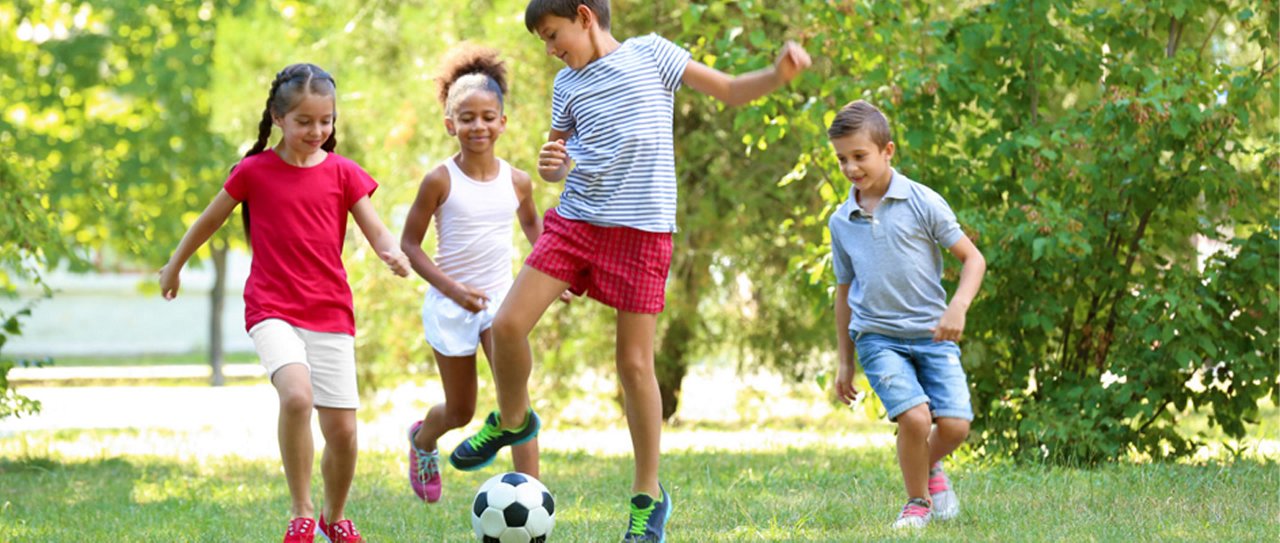How parents can help kids be fit and healthy

Childhood obesity is a serious problem in the United States, putting children and adolescents at risk for poor health. According to the U.S. Centers for Disease Control and Prevention (CDC), obesity affects about 13.7 million youth aged 2 to 19 years, with the highest percentages affecting Latino and African American populations.
Why is this a problem? Today’s inactive kids are tomorrow’s unhealthy adults. Few behaviors influence child health more than physical activity. But with cutbacks in school programs, increased screen time, and less playtime outdoors, kids are not moving enough. This affects their own health as well as that of their communities.
Being physically active is one of the most important parts of maintaining good health. Families play an important role in helping kids learn to be active and stay active throughout their lives.
How exercise benefits kids
It’s good for their brain. Studies found that regular moderate-to-vigorous exercise improved cognition, attention and academic performance in children aged 5 to 13. That means that kids who exercise do better in school.
It Improves behavior and sleep, which boosts the quality of life for kids and their families. Exercise improves heart health and builds strong bones and muscles. There is reduced risk of weight gain and obesity when exercising regularly. The benefits also decrease the likelihood of developing risk factors for diseases like type 2 diabetes and heart disease. Want to reduce anxiety and depression? Exercise is part of the answer as it encourages positive mental health and increased body confidence.
How much exercise should kids get?
Children and adolescents should get 60 minutes or more of physical activity each day, according to the Physical Activity Guidelines for Americans.
What kind of exercise do children and teens need?
Kids need activities that are age-appropriate, fun and provide variety. There are three types of physical activity that all children should do:
Aerobic activity – such as walking, running, biking, swimming, dancing, and playing active games like tag, soccer, and basketball. Aerobic activity should make up most of your child’s 60 or more minutes of physical activity each day.
Muscle strengthening – include at least three days a week as part of your child’s 60 or more minutes. Examples of muscle-strengthening activities for younger children include gymnastics, playing on a jungle gym, and climbing a tree. Examples for adolescents include push-ups, pull-ups, and weightlifting exercises. Children aged 8 and over may start a structured weightlifting program.
High-impact bone strengthening – such as rope jumping, running, hopping, skipping, and sports like gymnastics, basketball, soccer, and tennis. Include at least three days a week as part of your child’s 60 or more minutes.
Tips to help kids be fit and healthy
Keep it fun and age appropriate
Tailor activities to age, ability, and interests. The best activities for kids are interesting and enjoyable. Encourage your child to try new things until they find something they like. It’s highly unlikely they will want to stick with an activity they don’t enjoy.
Start small
Start slowly with exercise if they aren’t currently active. While at least 60 minutes is the goal, it’s okay to start with less and work up to more as they become more fit.
Help children play with their friends
Encourage your children to be active with their friends by playing tag, basketball, or by riding bikes, instead of watching TV or playing video games. Give your children toys that encourage physical activity like balls, kites, and jump ropes. Encourage your children to try a new activity, or join a sports team if they like sports.
Limit screen time
Screen time can keep kids from physical activity and disturbs sleep. The American Academy of Pediatrics recommends avoiding or restricting screen time during meals and within one hour of bedtime. It also recommends that children 2 years or older should spend no more than two hours a day watching TV, playing video games, and using the computer.
Or, use screens and tech more effectively
Movement-based games such as the Wii system or Pokemon Go are ways kids can play and move at the same time.
Activity trackers like Fitbit can also help encourage fitness. Make it fun: You could start a friendly family competition to see who can get in the most steps each day. Turn the kitchen chalkboard into a leaderboard, and offer a prize each week for the winner or for those who meet a certain number.
Blue Cross NC members can get discounts on fitness trackers through Blue365.
Provide a healthy diet
Kids need a healthy, balanced diet to fuel their daily activities, just as adults do. Provide a diet rich in fruits, vegetables, legumes, whole grains, nuts, and seeds. Limit added sugars, fast food, and processed foods. Drink water rather than sports drinks.
Set a good example
Model an active lifestyle for your kids. Do activities as a family, such as visiting parks or going hiking, swimming or skating. Find ways to fit exercise into your everyday life, such as walking the dog together or doing yard work together. Encourage walking or biking to school, if appropriate.
Urge schools not to cut PE class and recess
Talk with your child’s school to suggest before or after school physical activity programs if they are needed. Volunteer to help with after-school programs or sports teams.
It’s never too late to start
If we as parents do what we can to help our kids be fit and healthy today, we will help them grow into the happier, healthier adults of tomorrow.
Blue Cross and Blue Shield of North Carolina does not discriminate on the basis of race, color, national origin, sex, age or disability in its health programs and activities. Learn more about our non-discrimination policy and no-cost services available to you.
Information in other languages: Español 中文 Tiếng Việt 한국어 Français العَرَبِيَّة Hmoob ру́сский Tagalog ગુજરાતી ភាសាខ្មែរ Deutsch हिन्दी ລາວ 日本語
© 2024 Blue Cross and Blue Shield of North Carolina. ®, SM Marks of the Blue Cross and Blue Shield Association, an association of independent Blue Cross and Blue Shield plans. All other marks and names are property of their respective owners. Blue Cross and Blue Shield of North Carolina is an independent licensee of the Blue Cross and Blue Shield Association.





